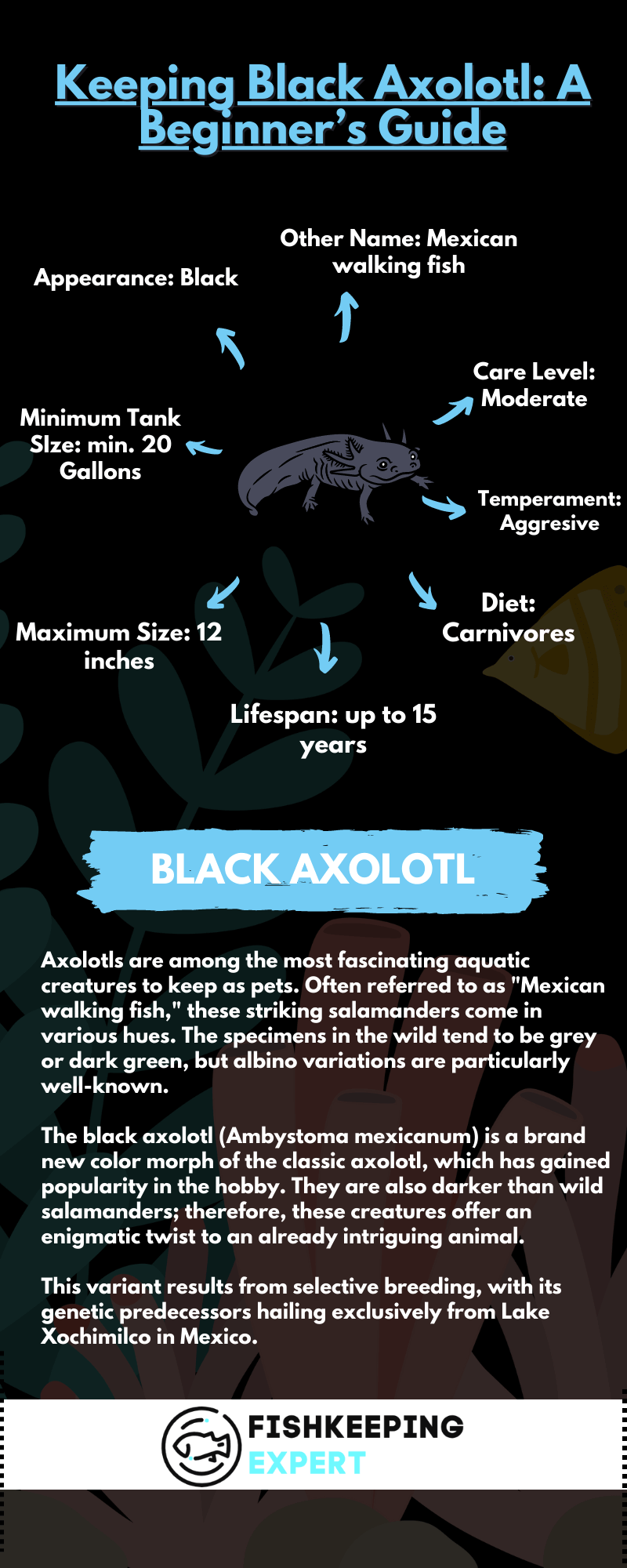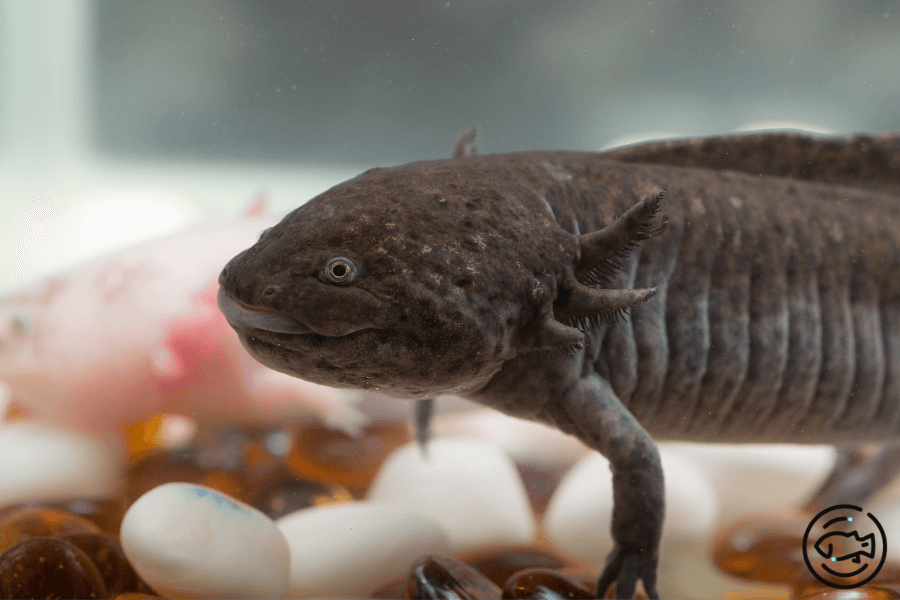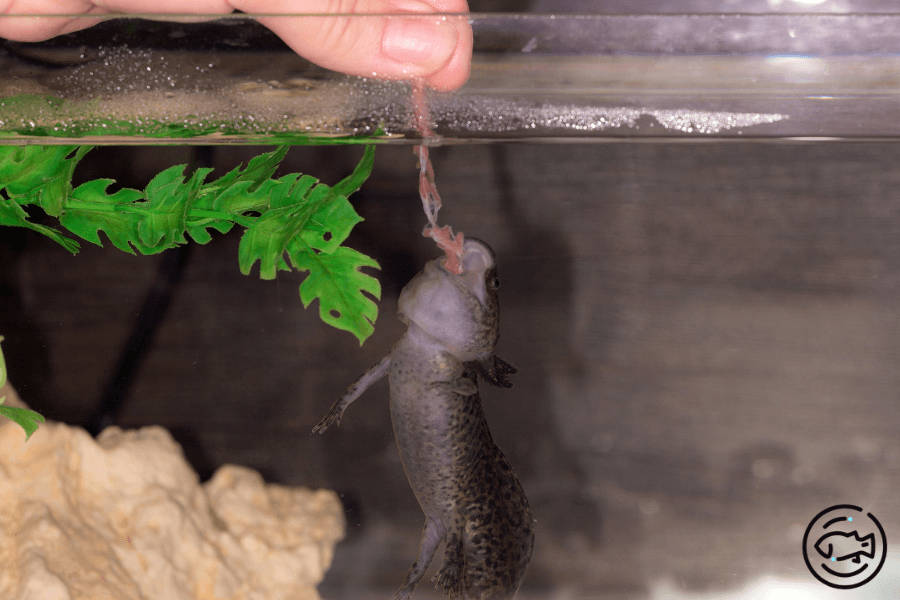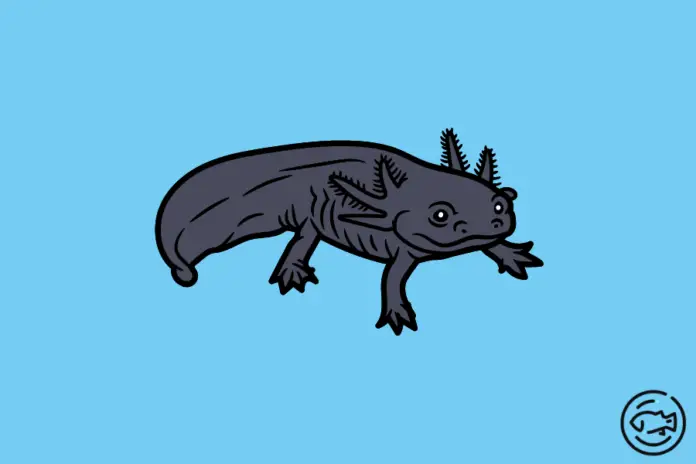This guide provides you with all the knowledge you need to know about black axolotls and how you should care for or manage them.
Overview

Axolotls are among the most fascinating aquatic creatures to keep as pets. Often referred to as “Mexican walking fish,” these striking salamanders come in various hues. The specimens in the wild tend to be grey or dark green, but albino variations are particularly well-known.
The black axolotl (Ambystoma mexicanum) is a brand new color morph of the classic axolotl, which has gained popularity in the hobby. They are also darker than wild salamanders; therefore, these creatures offer an enigmatic twist to an already intriguing animal.
This variant results from selective breeding, with its genetic predecessors hailing exclusively from Lake Xochimilco in Mexico.
One of the most remarkable characteristics of black axolotls is that they are neotenous. Neoteny refers to the phenomenon when an animal remains in its larval form.
Amphibians typically spend their larval stage in water before transitioning to land, but black axolotls remain in their aquatic larval forms throughout their lives.
The black axolotl makes for an entertaining pet, and you may even discover its individual personality over time.
It’s worth noting that black axolotl is not fish or lizards but amphibious salamanders.
Appearance

Black axolotls are an easily recognizable species due to their distinctive appearance.
The body structure of these critters is similar to that of a lizard because they have arms and legs but have exceptional biological adaptations to aid their aquatic life.
One such characteristic is their elongated and large tail, which has a tadpole-like structure when viewed from above, and fleshy fins running along the bottom and back.
The legs are shorter, with four webbed toes on the front feet and five on the back. The black axolotl’s most unique and cherished characteristic is the signature “headdress,” which consists of six frilly appendages that look like a crown and sprout from the back of its head.
The axolotl utilizes these appendages to breathe underwater. The appendages they have on their bodies are known as external gills.
Care
Caring for black axolotls in a home aquarium setting can be somewhat challenging.
Although they may be considered suitable for those new to raising amphibious creatures, some aspects of their care can be demanding.
Nevertheless, their habitat requirements are less extreme than some beliefs and are known for their adaptability.
With some experience in fish keeping, meeting their needs can be manageable. By adhering to these care guidelines, one can ensure the well-being and longevity of a happy and healthy black axolotl.
Size
Black Axolotls may be as short as a few inches if you buy them from a dealer or pet store.
However, these aquatic animals can overgrow to reach lengths of up to 12 inches over a short period.
Their tails take up a large part of that measurement. This doesn’t mean that these pets don’t need their own space.
Lifespan
Black axolotls are extremely difficult to obtain as they require years of commitment to obtain. Taking good care of them can extend their lifespan to as much as 15 years.
The life expectancy of your axolotl depends on a wide range of factors, as it does with any animal. In addition to genetic factors, the quality of care you provide plays a significant role in the outcome.
Tank Size
We can attest that the notion that these creatures require a large tank is a misconception. While they do require ample space to move and explore, they are not known for their brisk swimming.
This means that they are well-suited for relatively smaller enclosures. In our experience, a minimum of 20 gallons of water is sufficient to keep a single black axolotl.
While larger tanks are always preferable, this amount of water is ample for the axolotl to swim comfortably and decorate the tank with simple ornaments.
Tank Requirements
Black axolotls have the advantage of having relatively few decoration requirements compared to other aquariums.
In captivity, you can be sure that the creature will do well if you provide it with a natural-looking habitat and allow it to hide in case it needs any help.
It would be best if you used smooth gravel or sand as the substrate for the bottom of your aquarium. Sand is the preferred choice for most hobbyists since gravel may pose a problem when it comes to compaction.
And it is common for these salamanders to eat gravel by accident. It could stuff up their digestive system and, in this case, lead to life-threatening complications. Alternatively, you can have a bare-bottom tank if you don’t want to experience any possible compaction problems.
It is a good idea to add a piece of driftwood that is relatively large in the tank with the black axolotls. Finding an element that forms a natural cave would be best, as you can incorporate stones to create a lair.
In times of stress, black axolotls might need a place to hide when they feel nervous since they are shy creatures.
Without a small space, they may suffer from diseases linked to stress when they don’t have a chance to relax.
You can add some refinement to your tank by adding some plants, as other prospects are few.
Black axolotls require dim lighting conditions; thus, many hobbyists opt to utilize natural room lighting to mimic the day/night cycle rather than additional lighting equipment. It’s important to avoid using powerful lighting as it can cause stress to the axolotl.
As a result, traditional aquatic plants are not suitable for the habitat. Artificial silk plants are preferable as they do not require lighting and are more secure, reducing the risk of the axolotl dislodging them.
However, one exception to this rule would be floating plant species, which can benefit the habitat by staying on the surface and providing light while also shielding the axolotl from excessive brightness.
In terms of equipment, it’s recommended to invest in a high-quality filter and chiller if necessary. While some aquarists may argue that a filter is unnecessary, it’s wise to have one in place to manage the axolotl’s bioload, maintaining low ammonia levels and ensuring a stable tank environment.
Water Parameters
Expert aquarists have found that black axolotls have some unique water parameter requirements. They are native to Lake Xochimilco, which is located at an altitude of approximately 2,000 feet, leading to relatively cool temperatures throughout the year.
Although they are adaptable, they do not thrive in typical tropical fish conditions and may require a water chiller, depending on your location. However, they are less particular about pH and hardness levels, allowing for some flexibility.
It is important to maintain stability in water conditions to avoid unnecessary stress in your axolotls. Ideal ranges for water temperature are between 60 and 64 degrees Fahrenheit, pH levels between 6.5 and 8.0, and water hardness between 7 and 14 GH.
Behaviour
Despite their captivating and distinctive appearance, black axolotls are known to be aggressive and can cause problems for other inhabitants in the tank.
As natural predators, they will consume fish, snails, and shrimp that share the same environment. Additionally, their poor eyesight can lead to them biting at anything that comes close, including other axolotls.
However, it’s worth noting that black axolotls are generally gentle with their owners. One of the most enjoyable aspects of owning one is observing their unique personalities as they get comfortable in their new environment.
They will come to recognize you over time and may even interact with you through the glass. Their curious nature makes them a delightful species to raise, and it’s easy to form a personal connection with them.
Diseases
Black axolotls, while hardy creatures, can still be susceptible to various diseases. Their external gills are delicate, and poor water conditions can lead to health issues. Extreme temperatures or high ammonia levels can cause stress, making them more vulnerable to bacterial and parasitic infections.
Parasitic infections can often circulate to the habitat through food sources, mainly feeder fish. While they may not always cause problems, stressors such as environmental changes can create an opportunity for parasites to take hold. Common parasitic infections include those caused by anchor worms.
Bacterial infections can also affect black axolotls, targeting the gill filaments, mouth, eyes, or other parts of the body. Treatment for such diseases typically requires veterinary assistance and antibiotic medications.
Fungal infections, such as mycosis, can also occur, characterized by developing cotton-like growths on the skin and body. These infections are often a result of poor tank conditions and require careful treatment.
It is essential to avoid using salt baths without veterinary guidance, as excess salt in the environment can cause issues due to the axolotl’s porous skin.
Diet

Black axolotls are carnivores and require a diet high in protein to maintain optimal health. Providing food for these pets can be challenging due to their poor eyesight and selective dietary preferences.
Providing food items that are moving and have pungent odors is essential to entice them to consume a proper diet.
While it’s possible to acquaint younger black axolotls with consuming commercial pellets, success can be inconsistent. The most effective food options include live foods such as:
- Softened Frozen Foods with strong odors,
- Crickets,
- Ghost Shrimp,
- Bloodworms,
- Chunks Of Seafood,
- Mealworms,
- Earthworms
Once you find a suitable food mix, your black axolotl will likely be eager to eat. However, it’s essential to maintain a schedule to avoid overfeeding.
Adults should be fed once or twice a week, while juveniles must be fed thrice weekly.
If your black axolotl has difficulty recognizing food, try using tongs to present the food and wave it in front of the salamander, which may be sufficient to encourage them to eat.
Tank Mates
It is generally not recommended to house black axolotls with other tank mates, as their aggressive nature and the sensitivity of their gills can make cohabitation difficult and potentially dangerous.
While some hobbyists have had success with similarly sized creatures and large tanks, the risk of issues remains high.
The good news is that black axolotls are rather content living alone. They can thrive on their own by creating a rich and stimulating environment. Providing them with plenty of activities and hiding spots, they will be content in their solitary habitat.
Breeding
Reproducing black axolotls can be a delicate process, but it can be accomplished if you have a compatible pair that has grown together. It’s essential to note that introducing random adult axolotls to a tank together may lead to aggression and must be handled with care.
A pair that is well-acquainted, however, can coexist peacefully and may reproduce once a year.
To initiate breeding, set up a separate tank with artificial plants, as the female will use them to protect her eggs. Condition them with a high-protein diet, and lower the temperature slightly to stimulate breeding.
Females can lay up to 180 eggs and will scatter them on plants and other surfaces in the tank. Once the eggs have been laid, the temperature should be slowly raised. Within 15 days, the eggs will hatch.
Removing the adults and allowing the babies to develop independently is essential. Feed them high-protein foods three times weekly to promote their growth and overall health.
Conclusion
In a proper tank environment, black axolotls will make excellent pets for your aquarium if you are flexible enough to deliver the right amount of care.
Keeping these charming creatures is easier than it sounds, as each requires little care and attention.
Share your views in the comments section below if you are interested in discovering more about these amazing animals!


